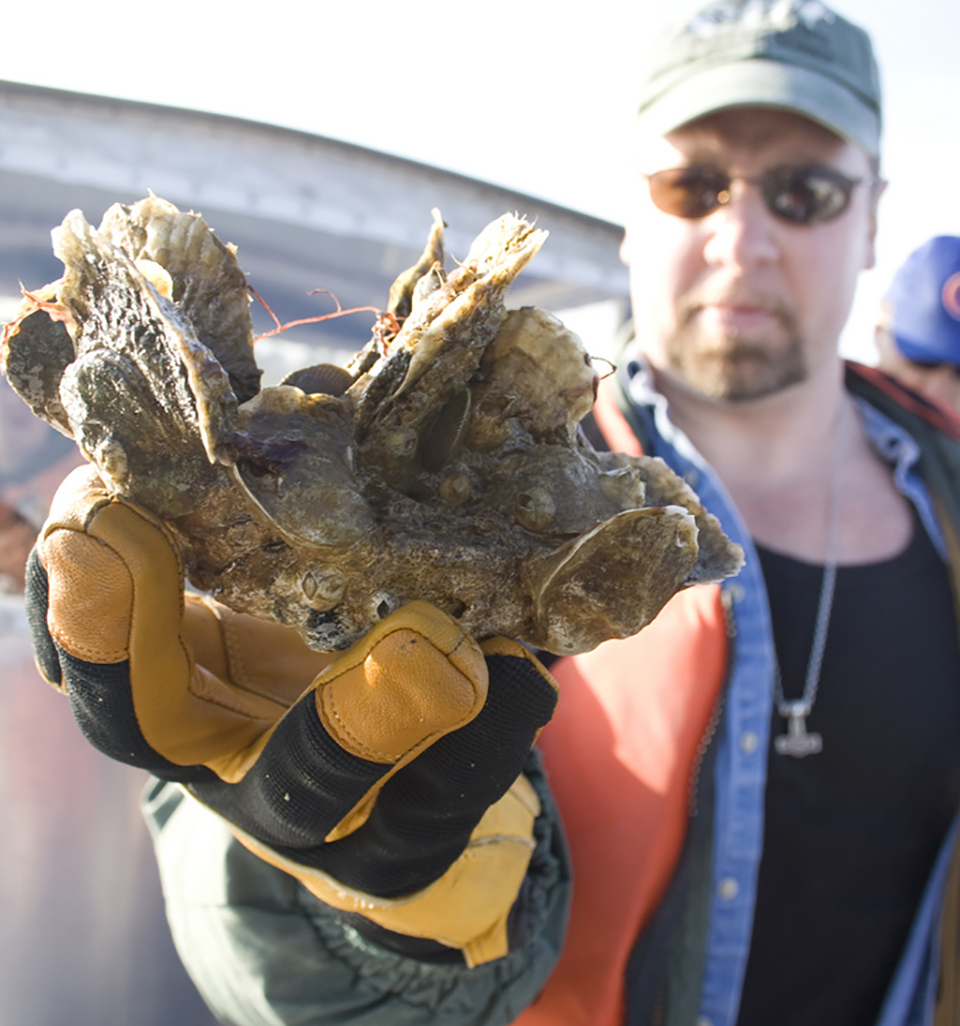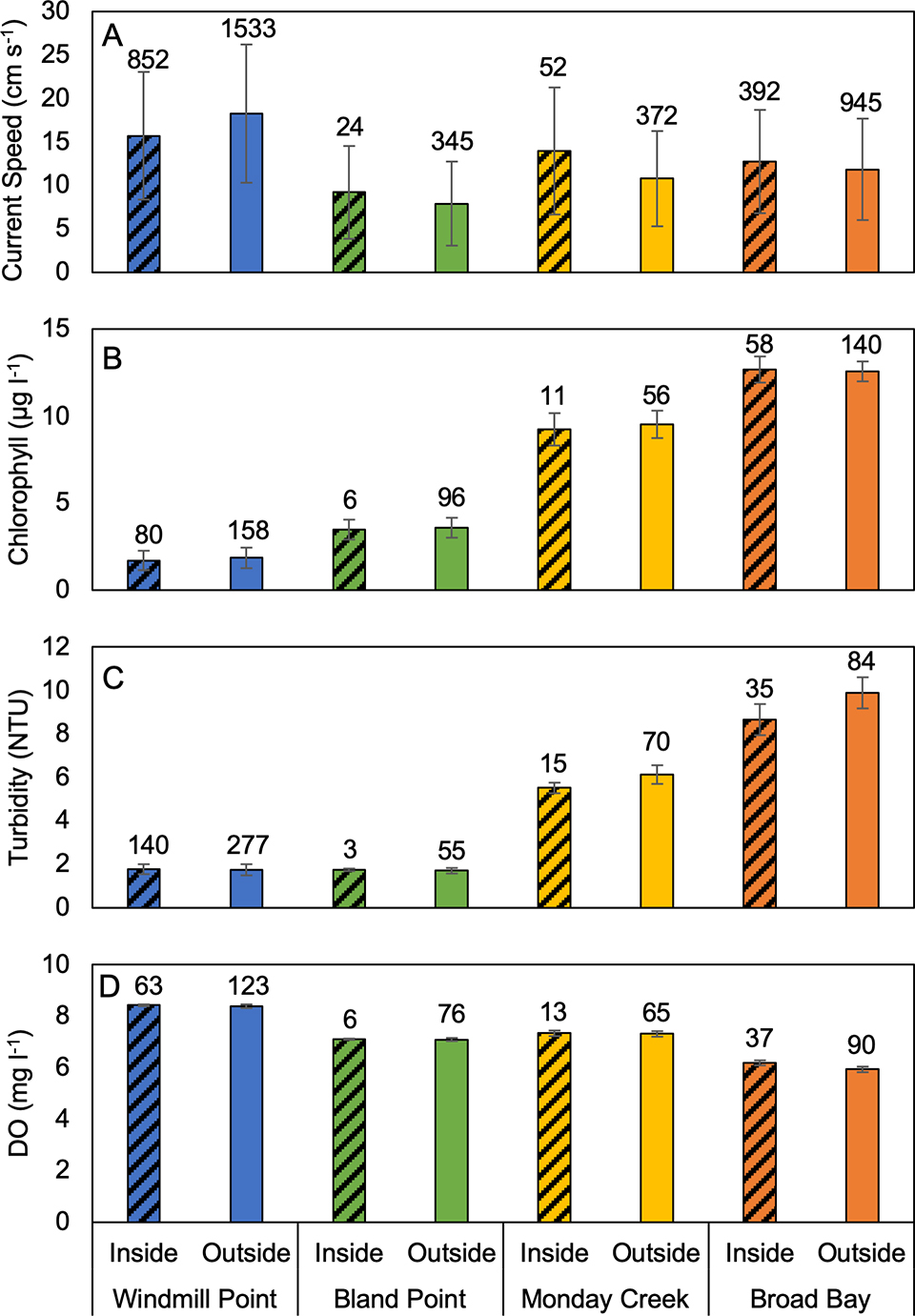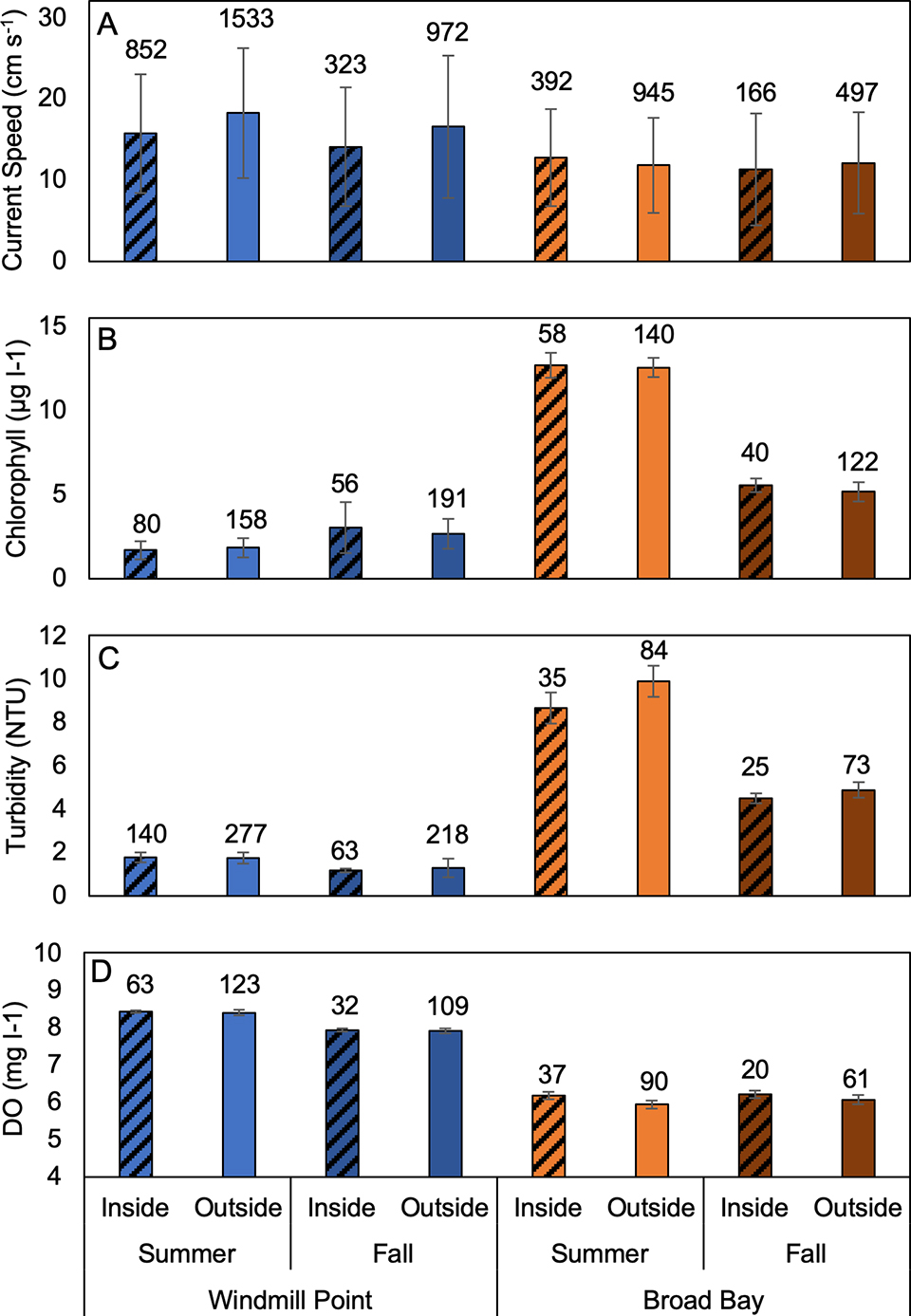Results show minimal effects on local conditions

Oysters are the largest-grossing marine species group for U.S. aquaculture. On the Atlantic coast, shellfish aquaculture growth and expansion can be controversial. Growers focus on the potential environmental benefits of aquaculture and its contribution to sustainable food production, while other stakeholders voice concern over viewshed, navigation and possible negative water quality and sediment impacts.
Research shows that water quality can be improved by oyster filtration. Oysters filter sediments, detritus, small phytoplankton and particulate-bound nitrogen and phosphorus from estuarine waters. When oyster filtration is added to small-scale ecosystem models and large-scale hydrodynamic models, results include clearer water, deeper light penetration and greater light availability to submerged aquatic vegetation.
Water quality can also be degraded by oysters. Oysters directly release ammonia into the water column via excretion, sometimes in substantial quantities. Excretion of ammonia by oysters is of concern because it can boost the local growth and regeneration of phytoplankton, potentially enhancing eutrophication in the summer. However, the flux of ammonia from oyster excretion to the water column has been found to be minor compared with the flux of nutrients released from oyster-associated sediments. Farming oysters in high densities also introduces the potential for organic enrichment of the benthos. And oyster aquaculture has the potential to alter hydrodynamic flow due to the position, size and density of shellfish aquaculture gear.
https://www.aquaculturealliance.org/advocate/in-delaware-bay-a-delicate-balancing-act-for-shellfish-farms/
This article – adapted and summarized from the original publication – reports on a study to examine four operating commercial aquaculture sites and quantify the positive or negative impacts of farms on the local water quality. A secondary objective was to broadly quantify the amount of potential filtration by oysters, in terms of total volume of water, in order to provide additional context for our results. The study hypothesized that water quality within the area containing cages (hereafter “inside”) would be significantly different from water quality outside of the extent of the cages (hereafter “outside”).
Field work was conducted with the help of Emily Mushlitz, Danielle Tarpley, Kelsey Fall, Moira Taylor and Ryan Moore. Jenny Dreyer was instrumental in processing samples for the related report and addendum to The Nature Conservancy. The authors thank Jim Goins for help with both vessel operations and field work. Field work was made possible via the use of the R/V Skimmer courtesy of the Chesapeake Bay National Estuarine Research Reserve in Virginia (CBNERR-VA). The authors thank Marjorie A.M. Friedrichs, Kenneth Moore, Lawrence Sanford and Courtney Harris for feedback and edits in the early stages of this manuscript. This work is VIMS contribution number 3857.
Study setup
Data on water quality, hydrodynamic regimes and sediment characterization were collected at four commercial oyster aquaculture sites in the southwestern portion of Chesapeake Bay (Eastern USA). Two of the farms used floating cages and the other two used bottom cages. Permission to access the aquaculture sites was given directly by growers.
Aquaculture sites differed in environmental setting but were similar in depth and salinity. The two northern sites were located in areas with greater fetch near deeper, wider channels than the two southern sites. Windmill Point was situated at the end of a peninsula exposed to the mainstem of the Chesapeake Bay. Bland Point lay in a broad open area near the mouth of the Piankatank River. Both Monday Creek and Broad Bay were located in more protected inlets. All sites had mesohaline salinities and mean water depths of ~1 meter (ranging from 0.5 to 2 meters depending on distance from shore and tidal stage).
For detailed information on the aquaculture sites; water quality and sediment sampling; water quality sampling cruises; conceptual farm-scale filtration calculation methods; and statistical analyses, refer to the original publication.
Results and discussion
Overall, our results show statistically significant impacts of farms on local water quality, but these differences are small compared to naturally occurring differences in water quality parameters attributable to differences between sites and seasons. Some evidence suggests that aquaculture gear at some farms may damp currents and provide substrate for microalgal growth on the cage structures. Finally, simplified filtration calculations support in situ results, showing that oysters in these settings are likely to process only a small fraction of the water volume passing through each farm during a tidal cycle.
Regarding farm and site effects, across all variables measured, the greatest differences were attributable to site effects rather than farm effects (Fig. 1). For current speeds, there was a significant interaction between the effects of site and farm (p < 0.001) requiring assessment farm effects within each site and assessment of the effect of site within each level of location relative to farms (i.e. inside and outside the farm footprint).

For current speed, there was a significant interaction between the effects of site and season (p = 0.014) but no interaction between farm effects and other factors (Fig. 2). At Windmill Point, current speeds were significantly lower in fall than in summer (p < 0.001). At Broad Bay, current speeds were similar between seasons (p = 0.10). As seen previously for summer, there were significant differences between sites in the fall (p < 0.001). The magnitude of differences in current speed between seasons at Windmill Point (1.8 to 1.9 cm s-1) was slightly less than the magnitude of differences between areas inside and outside the farm (2.4 to 2.5 cm s-1), which was roughly half the magnitude of the differences in current speeds between the two sites (2.8 to 6.6 cm s-1).

The setting of individual farms influenced water quality far more than the presence of oysters, which showed little impact consistent with either filtration or organic enrichment. Regarding the original hypothesis, although results did show statistically significant differences between water quality measurements inside and outside of farms, those differences were too small in magnitude and too inconsistent in sign to demonstrate evidence of farm impact. Therefore, results ultimately suggest minimal water quality modification by farmed oysters at the sites in this study.
The negligible impact of oysters at these sites is almost certainly due in part to the use of relatively low-density culture methods at sites with relatively high flushing rates. All farms in this study were situated in well-flushed areas with relatively short water residence times due to tidal currents and wave action. Farms in this study were also relatively low-density operations, with well-spaced cages resulting in < 60 oysters per square meter. This combination of growing conditions at the sites in this study are likely beneficial for both minimizing any potentially detrimental impacts of oyster aquaculture and maximizing oyster growth.
Results showing minimal effects of these specific oyster farms on local conditions as measured here are consistent with other studies of low-density shellfish aquaculture operations in settings with sufficient hydrodynamic flow. In short, our results support a key finding of other shellfish aquaculture studies: low-density shellfish farming at sites with relatively high flushing rates has minimal negative impact on local ecosystems.
Perspectives
This study investigated four commercial oyster farms in lower Chesapeake Bay and found minimal impacts of farms at most sites. For the water quality variables considered (chlorophyll, turbidity and dissolved oxygen), the effects associated with environmental setting related differences among sites and seasons were generally an order of magnitude greater than the effects of the farms.
Although large sample sizes were often able to resolve statistically significant differences in water quality inside vs. outside farms, the effects of oyster aquaculture on observed water quality variables rarely aligned with the expectation that aquaculture farms would decrease chlorophyll, turbidity and dissolved oxygen levels. The magnitudes of inside-outside water quality differences were small at all sites and seasons regardless of gear type.
Results suggest that among-site differences in water quality were more closely related to differences in environmental setting, in terms of bed composition and wave exposure, than to differences in farm characteristics. A simplified calculation revealed that at the low culture densities investigated in this study, oysters in farms are only able to filter a small fraction of the water passing through each farm on a given tide.
Now that you've finished reading the article ...
… we hope you’ll consider supporting our mission to document the evolution of the global aquaculture industry and share our vast network of contributors’ expansive knowledge every week.
By becoming a Global Seafood Alliance member, you’re ensuring that all of the pre-competitive work we do through member benefits, resources and events can continue. Individual membership costs just $50 a year. GSA individual and corporate members receive complimentary access to a series of GOAL virtual events beginning in April. Join now.
Not a GSA member? Join us.
Authors
-
Jessica S. Turner
Corresponding author and Ph.D. student
Virginia Institute of Marine Science
William & Mary, Virginia, USA -
Lisa Kellogg, Ph.D.
Virginia Institute of Marine Science
William & Mary, Virginia, USA -
Grace M. Massey, Ph.D.
Virginia Institute of Marine Science
William & Mary, Virginia, USA -
Carl T. Friedrichs, Ph.D.
Virginia Institute of Marine Science
William & Mary, Virginia, USA
Tagged With
Related Posts

Responsibility
In Delaware Bay, a delicate balancing act for shellfish farms
Oyster producers learn to adapt in a Delaware Bay ecosystem that's critical for endangered shorebirds and highly protected horseshoe crabs.

Intelligence
Farmers trade Kansas cornfields for Florida clam beds
The Stones came to Florida without experience in clams and no ties to the fishing community. Their backgrounds in farming, however, are proving valuable.

Intelligence
Shellfishiency: Oyster farmers step boldly into the digital age
The online platform Oyster Tracker is designed to help oyster farmers keep track of inventory and make better use of their time on the water.

Responsibility
To protect sensitive habitat, oyster farms turn to high-tech tools
Drones and GoPro cameras are helping researchers, regulators and operators understand how shellfish farming interacts with sensitive habitats like eelgrass beds.


